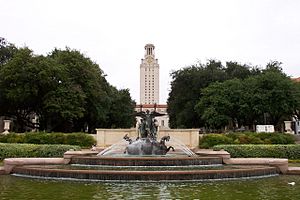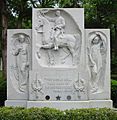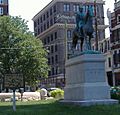Pompeo Coppini facts for kids
Pompeo Luigi Coppini (born May 19, 1870, died September 26, 1957) was a famous sculptor. He was born in Italy and later moved to the United States. You can find his amazing sculptures in Italy, Mexico, and many U.S. states. But most of his art is in Texas! He is well-known for his large monument called Spirit of Sacrifice (also known as The Alamo Cenotaph) at Alamo Plaza. He also created many statues of important people from Texas.
Quick facts for kids
Pompeo Coppini
|
|
|---|---|
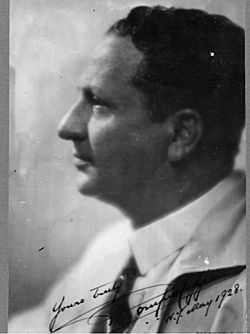
Pompeo Coppini 1929
|
|
| Born |
Pompeo Luigo Coppini
May 19, 1870 |
| Died | September 26, 1957 (aged 87) |
| Nationality | Italian (naturalized as U.S. citizen in 1902) |
| Education | Accademia dell'Arte del Disegno Augusto Rivalta |
| Known for | Sculpture |
|
Notable work
|
Partial listing - Sculptures, except where noted
Italy
Mexico
Kentucky
Michigan
New Jersey
New York
Texas
|
| Spouse(s) | Elizabeth di Barbieri |
Contents
Early Life and Art Training
Pompeo Coppini was born in Moglia, Italy, on May 19, 1870. His father, Giovanni, was a musician. His mother was Leandra Raffa Coppini.
When Pompeo was ten, his family moved to Florence. He started working, making ceramic horses that were also whistles. Later, he worked for a sculptor who made copies of famous artworks for tourists.
At age sixteen, Pompeo studied art at the Accademia dell'Arte del Disegno. His teacher was Augusto Rivalta. After he finished his studies, Coppini opened his own studio. He made busts (sculptures of heads and shoulders) of local famous people for free.
Moving to the United States
In March 1896, Coppini moved to the United States. He arrived with only a trunk of clothes and $40. He found a job in New York, sculpting figures for a wax museum.
He met Elizabeth di Barbieri, who came to model for one of his projects. They fell in love and got married. In 1902, Coppini became a citizen of the United States.
Even though he found work in New York, Coppini wanted to be more famous. So, in 1901, he moved to Texas. He joined another sculptor named Frank Teich.
Sculpting in Texas
Coppini was asked to create figures for a monument at the Texas state capitol. For the next fifteen years, he lived and worked in San Antonio.
He later spent time in Chicago and New York City. There, he worked on a big project for the University of Texas at Austin. He helped design the Littlefield Fountain and sculpted six statues for the campus.
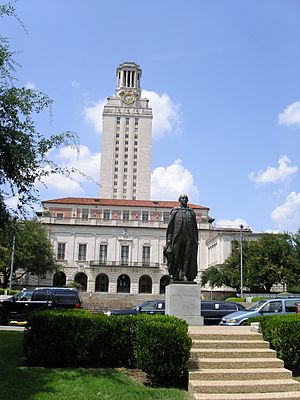
Around 1910, a sculptor named Waldine Tauch began helping Coppini. She was born in Texas. Tauch became like an adopted daughter to him. She was also his student and learned a lot from him. She worked with Coppini until he passed away.
In 1911, a group called the United Daughters of the Confederacy asked Coppini to design a statue. This statue, called Last Stand or Firing Line, honored Confederate soldiers. It was placed in De Leon Plaza in Victoria, Texas, in 1912.
Famous George Washington Statues
Coppini sculpted three different statues of George Washington.
- The first one was for Americans living in Mexico. It was put in Mexico City in 1912. But during the Mexican Civil War, the statue was pulled down.
- The second statue was made for Portland, Oregon, in 1927.
- The third statue was for the University of Texas at Austin. It was installed in 1955.
Later Life and Honors
In 1931, Italy honored Coppini with a special award called the Commendatore of the Order of the Crown of Italy. This was for his great contributions to art in America.
In 1934, he was chosen to design the Texas Centennial half dollar coin. In 1937, Coppini opened his studio in San Antonio. There, he worked on his famous Spirit of Sacrifice monument at Alamo Plaza.
Baylor University gave Coppini an honorary doctor of fine arts degree in 1941. From 1943 to 1945, he led the art department at Trinity University in San Antonio. In 1945, he and Waldine Tauch started an art group called the Classic Arts Fraternity. It was later renamed the Coppini Academy of Fine Arts in 1950.
Many of Coppini's sculptures are in Austin, Texas. You can see them at the Texas State Capitol and the University of Texas at Austin. His statue of Lawrence Sullivan Ross, a Texas Governor and president of Texas A&M University, is very popular. Students often put coins at its feet for good luck on exams.
Coppini also created a marble statue of Senator James Paul Clarke for the United States Capitol in Washington, D.C. He made two bronze sculptures at Baylor University in Waco, Texas. One is of former Baylor President Rufus C. Burleson (1905). The other is of Baylor University's founder, Judge R.E.B. Baylor (1939).
One of Coppini's favorite works was a bronze sculpture of John Reagan. Reagan was a U.S. Senator from Palestine, Texas. This monument, made in 1911, is in Reagan Park in Palestine.
Pompeo Coppini passed away in San Antonio on September 26, 1957. He even designed his own tomb for his resting place in Sunset Memorial Park.
Selected Works
- Jefferson Davis (1901–1903), Confederate Monument, Texas State Capitol, Austin, Texas.
- Confederate Monument (1903), Paris, Texas:
- Bust of Jefferson Davis.
- Bust of Robert E. Lee.
- Bust of Stonewall Jackson.
- Bust of Albert Sidney Johnston.
- Rufus C. Burleson (1903), Burleson Quadrangle, Baylor University, Waco, Texas.
- The Victims of the Galveston Flood (1903–04), University of Texas at Austin.
- Terry's Texas Rangers Monument (1905–1907), Texas State Capitol, Austin, Texas.
- Hood's Texas Brigade Monument (1910), Texas State Capitol, Austin.
- Come and Take It Monument (1910), Gonzales, Texas.
- Sam Houston Grave Monument (1910–11), Huntsville, Texas.
- John Hunt Morgan Memorial (1911), (former) Fayette County Courthouse, Lexington, Kentucky.
- John H. Reagan Memorial (1911), Palestine, Texas.
- Bust of Thomas Mitchell Campbell, Governor of Texas 1907-1911, (1911), Private Collection, Palestine, Texas
- Statue of George Washington (1911–12), Mexico City, Mexico.
- Confederate Monument (1911–12), Deleon Plaza, Victoria, Texas.
- Queen of the Sea monument (1914), Corpus Christi, Texas
- Bust of William Rufus Shafter, (1919), Galesburg, Michigan,
- Lawrence Sullivan Ross (1917–1919), Texas A&M University, College Station, Texas.
- The Spirit of the Texas Cowboy (1918–19), Charles H. Noyes Memorial, Ballinger, Texas.
- George W. Littlefield Commission (1920–1928), University of Texas at Austin:
- Littlefield Memorial Fountain, Paul Cret, architect. A World War I Memorial.
- John H. Reagan.
- Robert E. Lee.
- Albert Sidney Johnston.
- James Stephen Hogg.
- Jefferson Davis.
- Woodrow Wilson.
- Senator James Paul Clark of Arkansas (1921), National Statuary Hall Collection, United States Capitol, Washington, DC.
- Bronze doors (1926), Scottish Rite Cathedral (Masonic), San Antonio, Texas.
- Statue of George Washington (1926–27), Friendship Masonic Lodge 160, Portland, Oregon.
- Texas State Fair Hall of State (1935–36), Fair Park, Dallas, Texas:
- Stephen F. Austin.
- Thomas J. Rusk.
- William B. Travis.
- James W. Fannin.
- Mirabeau B. Lamar.
- Sam Houston.
- Cenotaph to the Heroes of the Alamo (1937–38), Alamo Plaza, San Antonio, Texas.
- Coppini Tomb (1953), Sunset Memorial Park, San Antonio, Texas.
- Statue of George Washington (1955), University of Texas at Austin.
Gallery
-
Rufus Burleson (1903), Baylor University, Waco, Texas.
-
Terry's Texas Rangers Monument (1905–1907), Texas State Capitol.
-
Hood's Texas Brigade Monument (1910), Texas State Capitol.
-
John Hunt Morgan Memorial (1911), Lexington, Kentucky.
-
Lawrence Sullivan Ross (1917–19), Texas A&M University.
-
General William Rufus Shafter (1919), Galesburg, Michigan.
-
James Paul Clark (1921), United States Capitol, Washington, DC.
-
Stephen F. Austin and Sam Houston (1935–36), Hall of State, Dallas, Texas.
-
Alamo Cenotaph (1937–38), San Antonio, Texas.


